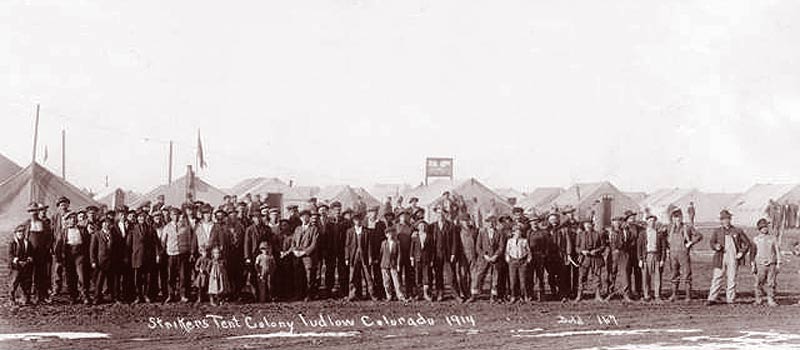
1914: The Ludlow Massacre
***
The Ludlow Massacre
Wikipedia
http://en.wikipedia.org/wiki/Ludlow_Massacre
***
This post was inspired by Dorothy Potter Snyder at http://www.dorothypotter.com/live/
***
This post was inspired by Dorothy Potter Snyder at http://www.dorothypotter.com/live/
***
On Sunday, April 20, celebrations of Easter will coincide with the centenary of the Ludlow Massacre, a bloody attack on workers for which John D. Rockefeller, Jr. was entirely responsible. On this day in 1914, Rockefeller unleashed Colorado Fuel and Iron Company thugs, professional strikebreakers hired from the Baldwin-Felts Detective agency and members of the Colorado National Guard on over 1,000 workers and their families.
Hired strikebreakers wore the uniforms of the state militia, and together these domestic terrorists launched a day of murder, looting and death by fire. The Ludlow Massacre launched retaliatory attacks against the mining industry all over the state; men, women and children who died on the site became martyrs to the American labor movement, and the strike is remembered as one of the most violent in the history of the United States.
Although workers were striking against many companies in Colorado coal country beginning in 1913, patriarch John D. Rockefeller, the majority stockholder in CF & I, was the largest employer in the state. He also had numerous public employees on his payroll. Although he succeeded in regaining control of his work sites, the attack was a public relations disaster for Rockefeller, a family that is better known today for its philanthropy than for its brutal labor policies in the United States and abroad. So on this centenary, let us also recall that, despite its many contemporary good works, this tremendously influential family continues to profit from the blood money extracted from workers in Ludlow and around the world throughout the late nineteenth and early twentieth century.
The workers at Ludlow were doomed once Rockefeller had decided to destroy the community they had established after their ejection from a company town where miners owed their housing, food and freedom to CF&I. Some town residents took to the hills when they saw troops massing outside of the tent encampment, where they were left entirely without shelter after the camp was turned into a graveyard. Those who stayed to defend the camp, or who waited until to late to flee, were subjected to a style of violent, sadistic retribution reminiscent of the numerous massacres of Native American people that accompanied the conquest of the United States. Throughout the day, Rockefeller employees shot both armed camp defenders and workers trying to escape; beat wounded residents and those trying to surrender with their gun stocks; looted valuables; and burned the canvas tents that had sheltered the community throughout the winter. Among the casualties that day were two women and eleven children who asphyxiated in a bunker built beneath their tent floor known as “the Stairs.”
I was reminded of this tragic event, which ranks as perhaps the deadliest and most violent labor conflicts in United States history, by Thai Jones’ excellent article in The Nation, “Remembering the Ludlow Massacre” (April 21, 2014). Jones is a historian of radical movements in the United States, and an assistant professor of history at Bard College; the article includes terrific references to help you learn even more about the context of this tragedy. A little snooping around uncovered another, more personal, commemoration by Coloradan Kirby Perschbacher. Pershbacher is descended from a mining family that was on strike but not present at the time of the attack (PagosaDailyPost.com, April 14, 2014.) As Parschbacher writes, technologies of mass death that would soon become typical of World War I were deployed against the immigrant workers. One weapon, known as the Death Car, was a railroad car exclusively used as a Gatling gun mount and troop carrier, and designed for terrorizing workers.
Although the United Mine Workers erected a commemorative monument designed by sculptor Hugh Sullivan in 1918, the site was not declared a historic landmark until 2009. The “coal wars” are commemorated at The Colorado Coal Field War Project, where archaeological investigations of the ruined camps are documented, and there will be numerous memorials throughout the year.
No comments:
Post a Comment